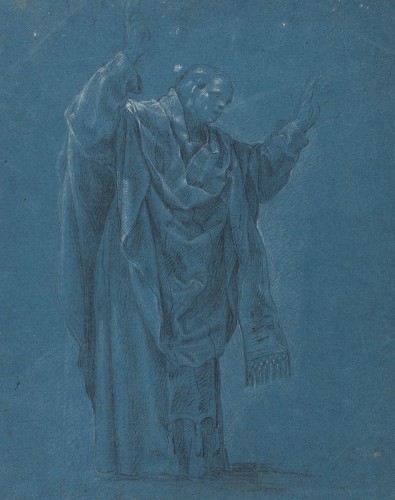Spanish Old Master Drawings
Saint Eulogius preaching
Francisco Bayeu
(Saragossa, 1734-Madrid, 1795)
- Date: 1783
- Black chalk and charcoal with touches of white chalk on blue paper
- 340 x 280 mm
The series of frescoes depicting the life of Saint Eulogius in the cloister of Toledo Cathedral was painted by Francisco Bayeu in the late 18th century. Bayeu, a prominent figure in Spanish Neoclassicism and brother-in-law of Francisco de Goya, was commissioned to decorate the cathedral’s cloister as part of a broader initiative to renew its artistic and religious narrative. The frescoes focus on key episodes in the life of San Eulogio of Córdoba, a 9th-century Christian priest, scholar, and martyr executed in 859 AD for defending his faith under Islamic rule. Bayeu’s compositions highlight scenes such as Eulogius preaching, writing, his trial and imprisonment, and his eventual martyrdom—all rendered with dramatic tension and compositional clarity. Importantly, preparatory drawings (dibujos preparatorios) for these frescoes have survived and provide valuable insight into Bayeu’s creative process. These works on blue paper reveal the artist’s attention to anatomical precision, gesture, and narrative sequencing. They also demonstrate how he carefully worked out the placement of figures and the emotional tone of each scene before executing the final compositions on the walls of the cloister. This drawing is characterized by Bayeu’s refined line work and classical influence, and some are held in institutional collections, such as the Prado Museum, offering scholars a deeper understanding of his methodology and the development of this ambitious project. Executed in fresco secco and designed to harmonize with the Gothic architecture of the cloister, Bayeu’s frescoes reflect both religious devotion and Enlightenment ideals. This cycle not only illustrates the life of a key figure in Spanish Christian history but also stands as a testament to Bayeu’s mastery of large-scale narrative painting in a sacred context.


